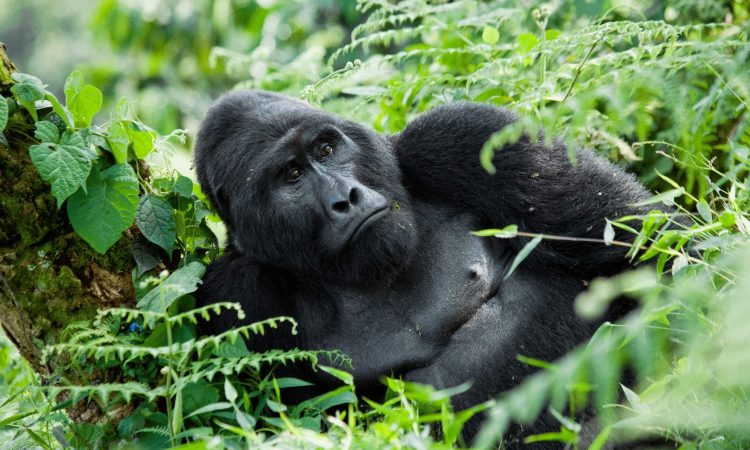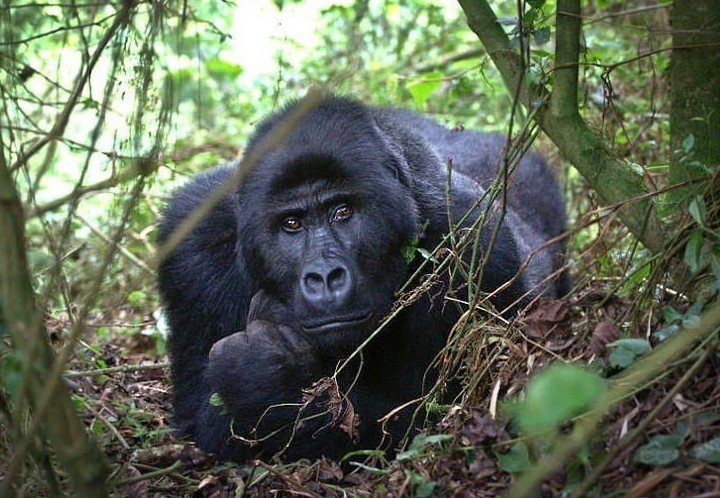How Difficult is Gorilla Trekking in Uganda? Because of the tough terrain, dense misty woods, and unpredictable weather, gorilla trekking in Uganda may be difficult. Gorilla treks also take occur at high altitudes of about 2,600m (8,500 feet).

One glimpse at southern Uganda’s emerald terraced hills and rocky terrain reveals that this region is not for the faint of heart. To reach the mountain gorillas, you must navigate uphill and downwards through dense tangles of jungle vines, roots, and thorns.
The intimidatingly called Bwindi Impenetrable National Park can only be reached on foot. There are no pathways, signs, or directions, and there are rarely any clearings (which is why park guards carry machetes). However, the payoff appears to be much greater after all of the effort.
Gorilla trekking in Uganda promises an adventure of a lifetime to many people traveling at high altitude and difficult terrain. A group of young uniformed men and women offer their services as porters at the park’s entrance. We strongly advise you to employ their services, especially if you are unsure how to navigate the terrain while carrying a daypack. Porters sell their services for a few dollars, providing a living for numerous residents of a local town.
Porters are frequently former poachers or persons who would have relied on the protected forest for a living. Many people will be compelled to revert to locating and capturing gorillas for bush meat or the criminal wildlife-trafficking trade if they cannot find work in gorilla conservation.
Poaching syndicates’ rewards can be quite profitable for poor communities with few other options for making a livelihood. It’s wiser to accept their assistance and pay the cost – which amounts to a few of coffees back home – to assure the continuing protection of gorillas.
Is gorilla trekking in Uganda Safe?
The thought of approaching such an intimidating beast is daunting. Gorilla trekking, contrary to popular assumption, is a risk-free exercise.
Primatologists have acclimated the tourist gorillas to human presence and implemented safety protocols to allow visitors to approach them securely. Mountain gorillas are formidable and unpredictable natural creatures, even when accustomed to human contact. If a silverback detects any malicious intent against you, they may rip you apart. To avoid harmful interactions, it is best to strictly follow the gorilla trekking regulations.
First, two armed rangers accompany you into the gorilla forest, protecting you from aggressive attacks and other unknown perils. If you stay with the trekking group, you will be extremely safe.
Second, remember that you are a visitor in the wild, and gorillas will accept your presence for the duration of your visit. To keep safe, do not do anything outside the guidelines of gorilla trekking. Throughout the excursion, pay attention to everything your guide says.
Third, because gorillas are susceptible to human sickness, it is illegal to reach out and touch them. They can, however, reach out and touch you at times, especially curious children. In such cases, avoid any interaction with the gorillas by not engaging them. If the silverback charges, instead of sprinting or making rapid moves, curl down in a submissive stance and he’ll back down.
Gorilla populations are already threatened by logging, poaching, and human encroachment on their habitat. Furthermore, they are extremely vulnerable to human illnesses. You will not only be unable to engage with them, but you will also be required to maintain a distance of at least ten meters (32 feet) at all times and wear a face mask. You will not be able to go gorilla trekking in Uganda if you are sick with the illness or something else. So make sure you’re in good health before going and take care to avoid catching a sickness on the plane.
One of the most cleansing and personal animal interactions in Africa is sitting a few meters away from a family of gorillas and seeing your humanity reflected in their warm-brown eyes and social rituals.
Why is gorilla trekking in Uganda worth the money?
You can’t put a price on a close encounter with a 400-pound silverback in its native habitat. Gorilla trekking is absolutely worth the money since you will not only have an unforgettable experience, but you will also be helping to save the endangered apes and their environment. The funds earned from gorilla permits are used to fund conservation activities.
Second, Uganda’s usual all-inclusive gorilla trekking tour is far less expensive than trekking in Rwanda. A gorilla trip would often involve a local airline ticket between Entebbe and Bwindi, transfers or transport to the gorilla sanctuary (10-hour drive or one-hour local flight), a $700 gorilla permit, and three or more days of lodging.
Hiking through the thick bush, following a tracker through the wealth of the tropical rainforest, wiping perspiration from your eyes and happy for your hiking gaiters, is priceless. Your tracker abruptly stops your trekking party – it’s time to encounter the dark-furred giants. Your guide turns with a big grin and says the words you’ve been waiting to hear: “There they are.” You go forward, unhurried, with nothing but your camera and the excitement of anticipation, to meet your protagonist.
You notice the shiny black bodies against the dazzling green of the jungle; this is why you saved your money. You’ve finally encountered a gorilla family led by a vigilant yet kind silverback male. The efforts leading up to this moment vanish in an instant, and an unusual sense of familiarity settles on you for the one wonderful hour you spend with the enormous forest giants.
Young gorillas wrestle like sumo wrestlers, while mother females assemble in grooming groups, occasionally reprimanding the young. Simultaneously, the patriarchal silverback maintains a watchful eye on his surroundings. Yes, the once-in-a-lifetime gorilla trip in Uganda is worthwhile.
Best Time for Gorilla Trekking in Uganda?
Although gorilla trekking is available all year, the ideal time to observe mountain gorillas in Uganda is from June to August and December to February. The forest floor is drier and less slippery during the dry season. There’s also a lower possibility of rain throughout your journey, and photography will be more rewarding.
During the heavy rains of April and May, the roads may become impassable, and your Uganda safari schedule may be disturbed by unwelcome annoyances. The wet seasons in Uganda are considered low tourist seasons, with fewer visitors and properties lowering their fees to entice the few that can come.
Some brave visitors who can survive the soaking treks take use of the low season to take advantage of bargains and the wonderful seclusion at places. During the wet season, you may find yourself alone in the entire resort or trekking with only the rangers.


